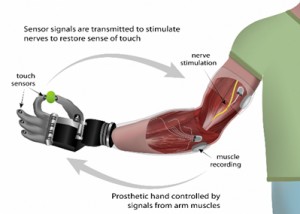bioCXN™ - An Ultraflexible Material to Enable Direct Communication Between Nerves and Prosthetics
Recent Advances Have Revolutionized Prosthetics

Significant advances in materials, sensors, and electronics, coupled with improved understanding of the nervous system, have resulted in prosthetics that are able to mimic the natural movement and function of the lost limb of an amputee. New research has demonstrated the ability for these devices to communicate directly with the brain and provide the sensation of touch via the insertion of electrodes into the patient’s brain. Ongoing Defense Advanced Research Projects Agency (DARPA) programs seek to advance this technology even further by linking the prosthetic to nerve endings in the stump of the amputation, providing motor and sensory communication between the device and the brain. However, before these exciting prosthetic technologies can be utilized by wounded veterans, DARPA needs a method to “plug” the devices into the existing nervous system. If the material doesn’t accurately match the mechanical properties of nerve tissue, it may shred the nerve and result in scarring, bleeding, or neuronal damage.
bioCXN™ Can Provide the Needed Solution for Connecting to Nerves

Luna is developing an ultraflexible material with the biologic and electronic properties required to interface with the nervous system. In partnership with Dr. Ken Yoshida of Indiana University – Purdue University Indianapolis, Luna is developing “bioCXN” – a fibrous material system that provides compositional flexibility and better matches the mechanical properties of native nerve tissue without compromising electronic functionality.
This research is being sponsored by DARPA under the HAPTIX program. Luna has demonstrated a significant reduction in elastic modulus and has achieved bulk material conductivities within 10x that required for use in vivo. Luna has investigated a variety of chemistries that provide varying biologic, electronic, and mechanical properties for this advanced material system.
Luna’s bioCXN is Widely Applicable for Novel Flexible Electronics
Though this exciting material technology is currently being developed for implementation with existing neural interface designs, it is an adaptable materials solution that may also be applicable to other neural and biological interfacing technologies in the future. The flexibility and cloth-like nature of this material also opens the possibility for application in wearable sensor applications, including breathable, non-woven materials with integrated sensing components that maintain similar mechanical properties to their carrier. Luna envisions potential applications in the development of performance tracking textiles for interfacing with apps to track motion, heart rate, and sleeping patterns, or sensors for diagnostic sensing and detection of neurodegenerative diseases. The comparatively low-cost nature of the material production process enables a wide array of potential applications outside the neural interfacing market.
This material is based upon work supported by the Defense Advanced Research Projects Agency under Contract No D16PC00095. The views, opinions and/or findings expressed are those of the author and should not be interpreted as representing the official views or policies of the Department of Defense or the U.S. Government.